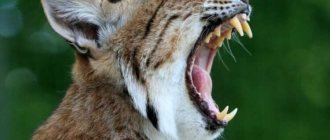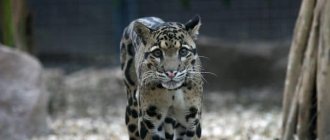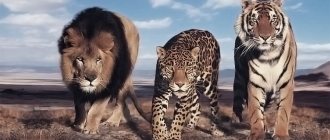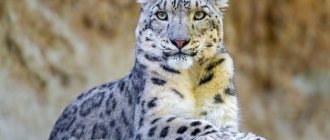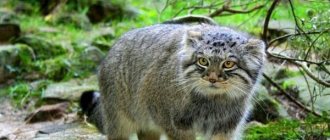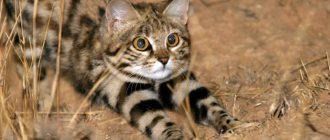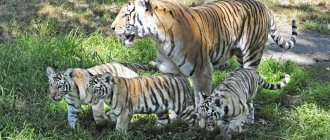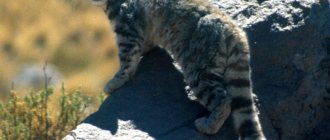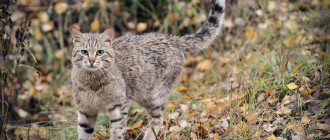The European forest cat is not a breed, much less a feral specimen of a domestic pet. This is exactly the type of cat from which, apparently, most of the natural breeds of cats known to mankind originated.
Wild European cats can be found in many zoos around the world. At first glance, these animals are no different from domestic cats. Moreover, in fact, these are dangerous and intelligent predators that are adapted to live only in natural conditions.
History of the species
Scientists believe that the Forest Cat appeared in the Pleistocene era, which began more than 2.5 billion years ago and ended 11.7 million years ago. Considering that humanity is only 2.8 billion years old, wild cats are at least 9 years older than humans.
The end of the Pleistocene era is characterized by an incredibly harsh climate. The planet had just experienced an ice age, the ice masses were retreating reluctantly, weather conditions also changed in waves - periods of sharp warming alternated with periods of the onset of very cold air masses. These processes served as an impetus for the transformation of flora and fauna. It was at this time that the woolly rhinoceros, mammoth, giant deer, cave lion and many other species appeared, most fully adapted to harsh climatic conditions.
With subsequent global warming, most animals of the glacial and post-glacial periods were unable to mutate and became extinct. The cat, which went into the shady forests and mountain ranges, managed to survive.
Thus, we can only talk about the approximate, latest date of the emergence of the European forest cat as a species - 11.7 million years ago. Although, most likely, this animal is older and has survived to this day since the Ice Age without any special changes.
The domestication of cats occurred much later, about 10 thousand years ago, when people began to lead a sedentary lifestyle, build homes, develop agricultural land and stockpile food.
Canadian lynx. Canadian Lynx (Lynx Canadensis)
The Canadian lynx is a species of lynx that lives in the North American taiga. The closest relative of the common lynx.
Felidae evolved into a separate family approximately 25 million years ago. Since then, they have expanded their habitats around the world and adapted to suit their environment. Cats not only prefer meat, they are all carnivores and cannot exist without it, although there are also spoiled pets who can feast on sweets from your table. According to researchers, the cat family is divided into 37 species based on molecular data. Get to know all the species, or almost all of them, because many animals are still simply unknown to science, rare cats on one page, and not scouring the entire Internet!
It’s strange why the lynx is considered a rare species of wild cat?
Mr. Cat recommends: characteristics
The Central European forest cat, Felis silvestris silvestris or European Wildcat, is a predatory mammal of the cat family. The Latin name for Forest Cats can be roughly translated as “a wild cat living in the forest.” They live on almost the entire planet, namely in Europe, Asia and Africa (steppe species are distinguished there). To learn more about the classification and understand it, read the article about Steppe cats. This article will focus only on those wild Forest cats that have acclimatized on European territory.
This is a small animal, which is still larger than an ordinary domestic cat, although it is very similar to it in its general structure:
- The body is quite long, elongated, muscular.
- Male individuals are from 45 to 93 cm in length, weigh 6-9 kg; females from 39 to 78 cm and 4-7 kg.
- The limbs are of medium length with sharp claws that can be hidden in the fingertips. They are well adapted for climbing trees and rocks, hunting and protecting themselves from enemies.
- The hind legs are somewhat longer and more powerful than the front legs. They help the animal make high jumps.
- The tail is of sufficient length (from 18 to 41 cm), usually slightly larger than the size of the body. Wide at the base and slightly tapering further, but its tip is not pointed, but rounded.
- Large head with developed wide cheekbones. The jaw is short and blunt. European forest cats have a larger cranial volume than domestic cats, a ratio known as the Schauenberg index.
- The ears are medium in size (5-7 cm), widely spaced, without tufts at the tips, but with inner feathering.
- The vibrissae are voluminous, thick, and white. Near the mouth there are 8-18 of them on each side, 5 to 8 cm long, near the eyes there are fewer of them - 7-8 and they are shorter (5-6 cm). But they are also on the inside of the hand, this is a group of 3-6 hairs 4-5 cm long.
- The eyes are large and widely spaced, with a slit-like vertical pupil. The iris is colored yellowish, greenish or emerald-golden.
- The lobe is flat, large, brick-colored.
- The coat is of uniform medium length throughout the body, it is much longer on the tail, making it appear large and fluffy.
- The undercoat is thick and voluminous. Because of it, the animal is perceived as much larger.
- Color in grayish tones. There are patterned lines on the head, back, sides, and tail. There are usually four clear lines on the back of the skull.
- The tail is surrounded by black rings, from three to ten.
- Summer fur after molting is much lighter, without ocher and brownish impurities, sometimes ashy.
- They usually have four pairs of nipples: two on the chest and two on the belly.
- The chromosome set includes 38 diploids.
European wild cats mainly live in deciduous and mixed forests, where there are no human settlements. Populations are also found on coasts and in coastal forests, near wetlands, and on hills. Avoid high mountain areas, snow-covered areas with a high thickness of cover.
The Central European forest cat is much larger than its wild relatives from the steppes. There are even males weighing 14-16 kg. The closest relatives of these animals are swamp lynxes and manulas.
Puma
Completing the list of the cat family is an elegant animal that combines power and beauty. The scientific name of this animal is Puma concolor, which translates as “one-color puma.”
The first detailed description of this graceful animal was compiled at the beginning of the 16th century. It is noteworthy that since then, interest in the puma has not waned. Scientists have repeatedly made attempts to tame this predator, but they did not end very successfully.
The name “puma” itself is not the only one for this animal. In different parts of the planet it is also called the mountain lion and cougar. The puma is one of the largest wild cats. It is second only to the tiger, lion and jaguar. The body of this male can reach a length of 180 centimeters and a weight of 100 kg. At the same time, female individuals are approximately 30% smaller.
The animal lives in the United States of America. Moreover, the color of its coat depends on the location. In the northern regions, the puma’s body is colored gray, and in the southern regions it is red.
Varieties of Wild Forest Cat
The wild forest cat includes 23 subspecies, including, in particular:
- Central European Felis silvestris silvestris;
- Caucasian Felis silvestris caucasica;
- Turkestan Felis silvestris caudata;
- Omani Felis silvestris gordoni;
- Steppe Felis silvestris lybica;
- African subspecies Felis silvestris cafra;
- Chinese Felis silvestris chutuchta;
- Domestic Felis silvestris catus.
Habitat of the European Forest Cat
Most populations of European forest cats live in the west and center of the continent - in Western Ukraine, Moldova, Slovakia, the Carpathians and Transcarpathia. A subspecies, the giant Iberian cat, also lives on the Iberian Peninsula.
The European cat is also found in the Caucasus, where it is adjacent to Felis silvestris caucasica. A fairly large part of them have lived in Scotland since ancient times, but now they are under threat of extinction due to widespread interbreeding with domestic cats.
The Ukrainian population lives mainly in broad-leaved hornbeam-oak, beech and other mixed forests. The Moldavian also chose beech forests for its habitat, but is also found in floodplains. These are dense thickets of tallow and reeds with rare hollow willows and sedges.
The European part of Russia, Germany, southern Spain, Italy are also among the places where the European forest cat lives.
These animals are able to live at an altitude of 2-3 thousand meters above sea level. Their thick coat with a warm undercoat can withstand large temperature changes, heat, high humidity and frost.
Between the late 17th and mid-20th centuries, the cat's habitat became fragmented due to large-scale hunting and regional extermination. The animal may have completely disappeared in the Czech Republic and is considered regionally extinct in Austria, although stray individuals from Italy still migrate there. The species has never inhabited Scandinavia, and Sicily is the only island with a population of these animals living there.
Sand or dune cat. Sand Cat (Felis Margarita)
The sand cat is distinguished by the smallest size among wild cats: its body length is 65-90 cm, with 40% occupied by the tail, height at the withers is 24-30 cm; the weight of adult males is 2.1-3.4 kg, females are smaller. The head is large and wide, flattened, with sideburns. The ears are very large and wide, without tufts.
The range of the dune cat looks like a strip starting in the Sahara (Algeria, Morocco, Chad, Niger) and through the Arabian Peninsula running into Central Asia (Turkmenistan, Uzbekistan, Kazakhstan) to the outskirts of Nushka in Pakistan.
Features of behavior
European forest cats are very careful, they can even be called shy. This often leads to manifestations of aggression towards strangers. These cats especially avoid human settlements and try not to be seen by people at all. In general, they prefer not to enter into conflicts with their relatives or with any other predators.
They live alone. An adult male is able to control a forest area of up to three square kilometers. To mark boundaries, the cat leaves marks from physiological secretions and claw marks on tree trunks. Therefore, strangers rarely wander into its territory.
The European forest cat has many natural enemies - lynx (Lynx), large steppe cat, jungle cat (Felis chaus), fox (Vulpes Vulpes), gray wolf (Canis lupus), jackal (Canis aureus), marten (Martes martes), bear (Ursus arctos). In Tajikistan, the wolf is the most serious competitor for the Forest cat; quite frequent destruction of cat holes is observed here. Birds of prey, including the Eurasian eagle owl (Bubo bubo) and saker falcon (Falco cherrug), are often quite successful at preying on cat kittens. Naturalist Seton Gordon recorded an incident where a Forest cat fought with a golden eagle (Aquila chrysaetos), resulting in the death of both parties.
The animal spends most of the daytime in a den, most often built in an old hollow in a large tree. Tree hollows usually contain enough sawdust, so the cat does not make additional bedding. If fleas appear in the den, the Steppe cat moves to another place. In winter, when snowfall prevents the cat from traveling long distances, it remains in its shelter until the climatic conditions for movement improve.
Those individuals that live in the mountains make rookeries in rock crevices or abandoned burrows of badgers (Meles meles) and foxes (Vulpes Vulpes). They are small depressions under cliffs, dense accumulations of branches; for Wild cats this is not only a den, but also a temporary shelter in times of danger.
Crevices in rocks or holes, equipped as shelters, are lined with dry grasses and bird feathers.
In the floodplains, animals choose wide forks of trees and abandoned nests of large birds, such as herons, for shelter and resting places.
The predator goes out for prey at night, several hours before dawn. But in winter conditions it practices additional hunting early in the morning and late in the evening.
European forest cats living in floodplains control up to one or two hectares of territory, but during the mating season, males can leave the boundaries of their territory in search of females.
The European forest cat is capable of moving very quickly when pursuing prey or escaping from pursuit, and is an excellent climber of trees and low rocks.
The animal has excellent hearing and vision, and a slightly lower level of smell. It is silent, but capable of making low and hoarse meowing sounds, and can purr, snort, purr, and hiss.
Due to the large number of enemies in the forest, from which, however, the predator is able to instantly hide in trees and rock crevices, the appearance of the beast is associated with a gloomy and wary creature. Nevertheless, this is one of the most beautiful and noble animals in the world, somewhat reminiscent of an exotic domestic cat.
Character of Siberians
The Siberian is a unique forest cat, because it has a character that brings together the best qualities of felines:
- The animal easily adapts to any living conditions and can feel comfortable anywhere.
- There is something of a dog in this breed - it is an excellent watchman, its sensitive hearing and sense of smell allow it to detect danger and the enemy at a great distance.
- The forest beauty will not interfere with your household chores, observing your busyness; she will find a time devoid of fuss and tactfully ask for your attention.
- The strong character of the fighter does not detract from her tenderness and affection - the love of Siberians is off the charts. The animal happily basks in the arms of its owner and loves when they communicate with it.
- Siberians are considered natural-born nannies for the smallest children. A forest animal is able to raise a puppy, the only thing a pet does not get along with is rodents, instinct kicks in.
- Protecting the owner, the animal can rush into battle with a large animal, not being afraid of the sad outcome of a brutal fight. When a stranger whom the Siberian does not know is nearby, the purr warns of danger. Another cute nuance - the fluffy dog loves to bring his owner “gifts” in his teeth, and if he lives in the private sector, these are not slippers, but neighbor’s chickens and dead mice.
- The adoration of the forest cat does not develop into obsession; the delicacy of the Siberian can be envied.
- To accustom your pet to its name, it is enough to constantly repeat the name when calling it to eat or for a walk. The nickname will be remembered in just a couple of days.
- Forest animals look massive, so ordinary people have doubts about how agile the animal is. But in vain, because the cat remains surprisingly graceful, graceful and swift - quickly overcomes obstacles and climbs up the smallest ledges.
- The mustachioed one is not known for rashness and thoughtless actions - before doing anything, the purr first makes a balanced decision, and in 90% of cases it is the most correct one. One can only envy the ingenuity of the beast.
- Doctors call the advantages of the breed the cat’s healing ability to treat its owners from osteochondrosis, neuralgic pinching and even pain arising from rheumatism.
Diet
European forest cats are typical medium-sized predators, the average prey of which is varied:
- hares;
- rabbits;
- land birds;
- martens;
- proteins;
- water rats;
- muskrats;
- stoats;
- caresses;
- ferrets;
- baby deer, chamois and roe deer;
- wild and domestic goats;
- hoarding rats;
- hamsters;
- lizards;
- snakes;
- small rodents (mice, voles, dormouse).
Partridges, chukars, rail birds, ducks and pheasants are especially vulnerable to attacks by the European Forest Cat. The predator not only attacks them, but also destroys their nests. Previously, these animals even hunted bustards and eagles.
When hunting for ducks, animals can swim, but they do this extremely rarely; they do not like water. Although occasionally they do not refuse to feast on frogs, crayfish and toads, this is truly a delicacy for them. Sometimes European forest cats, although extremely rarely, enter human settlements to hunt turkeys, ducks, geese, and chickens.
Despite the fact that the predator can move very quickly, when hunting it does not use the role of a beater, but prefers to take a wait-and-see position, watching for prey at a hole or nest. Then follows a rapid jump and the death of the victim. In this case, the cat kills small individuals by gnawing the occipital bone, and jumps onto the back of larger ones and tries to tear the neck. If the attack is unsuccessful, the cat will not pursue the prey, but will look for another victim.
The Forest Cat's vision is designed in such a way that he is able to concentrate only on a small area of the territory, the rest of the space is blurry for him, and he is not able to track a fast-moving animal. But he can make simply gigantic jumps for his size - two to three meters in length and height.
These animals are very voracious; a three- to four-month-old kitten can eat up to ten medium-sized mice per day, and an adult up to one and a half to two kilograms of fresh prey. Although the European cat is a relatively small animal, it is a brave and fearless hunter. So, not every hunting dog will dare to attack a rat or a hamster, but he boldly rushes at these evil rodents.
Hunting for martens, ermines, weasels or ferrets is also dangerous, and the cat does not always emerge victorious from that fight. Many young individuals die in such battles.
The first hunt usually takes place a few hours before dark, and the second closer to dawn. On cloudy summer days, the animal can leave the den during the day.
It usually eats prey by sitting on the ground on its hind legs and holding the carcass with its front legs. It does not tear out pieces of meat, but bites them off with its fangs.
European cats' hearing is so well developed that it picks up sounds up to 25 thousand vibrations per second, that is, it is able to hear the movement of a shrew.
Lifestyle and habits
The way of life of a wild cat is to hunt at night. If the weather at night is unfavorable - it’s raining or just slushy, this animal will prefer to stay in its own rookery and will not go fishing.
On fine days, the furry predator hunts in the evening, before sunset, or in the morning, in the predawn hours. How exactly a forest cat hunts can be imagined by analogy with its domestic companions.
Naturally, a forest predator will be faster and more accurate and will make every effort not to be left without prey. After all, hunting is, in fact, the only source of food.
Cats can sit in ambush for hours, waiting for the moment when the victim approaches them within one jump. After which an instant jump occurs, at the end of which the cat grabs the throat of its victim with its teeth. At the same time, he helps himself with the claws of all four paws.
These tailed predators can catch and eat up to 20 rodents with a total weight of about 500 grams in just one hunt. Spotted wild cats live alone and protect their territory from their fellows.
They spend the day in their lair.
Their lair can be:
- abandoned alien hole;
- comfortable rookeries in trees with enough space for the animal to curl up comfortably and doze while waiting out the daylight hours.
- cracks in stones.
In winter, when the amount of food decreases, wild cats approach villages and often hunt domestic birds.
Puberty and reproduction
The European forest cat is a pronounced individualist with a difficult and secretive character, but during the mating season the animal transforms. He becomes extremely active and proactive in his search for a mate.
Reproduction usually occurs twice a year. The first mating season occurs in January-March.
Female and male individuals make loud calling sounds and actively mark their territory. Males chase females and often fight with each other for the right to own a female.
After mating, the female begins to prepare a den - she selects a hollow or hole and lines it with dry herbs, leaves, and feathers of eaten birds.
In April-May the birth of the first litter occurs, which usually contains from three to six cubs.
The babies are small (150-200 g), covered with dark down, blind and absolutely helpless. Their coloring is more spotted than that of adults and is more consistent with the ancient type.
After the birth of kittens, the male leaves the female and does not take part in raising and raising the offspring.
The mother feeds the babies with milk for up to three or four months, protects them from affection and ermine, and, if necessary, moves them to a new place.
From one and a half months, the cubs begin to crawl out of the hole, play actively and try solid food. They learn to climb trees, where they hide in case of danger.
From two months of life, European forest kittens begin to learn to hunt, and at five or six they are able to live independently. Although females reach sexual maturity only at nine months, and males only at three years.
When the teenagers leave their mother, the next rut begins. During this period, cats try to position themselves closer to the free cat and still start endless fights among themselves.
The strongest male eventually takes the lead and becomes the father of the new, hardiest offspring.
Sometimes females mate with stray cats, most often feral domestic ones, and then the species degenerates, since genetically these varieties are very similar and are capable of hybridization. The issue of degeneration due to mating with domestic cats is debatable, since they are much weaker than their wild counterparts.
Sometimes domestic cats lost in the forest often become friends with European wild cats. The offspring remain in the forest and mix with the main population, significantly weakening it genetically. Although scientists' opinions on the scale of degeneration from such hybridization vary greatly.
There is no doubt that it was from wild cats that domestic cat breeds such as the Norwegian Forest and Siberian originated.
Snow leopard or snow leopard
Currently in Altai it is a very rare animal. It is preserved in only three or four scattered habitats, isolated from one another over long distances, in the most distant mountain areas. And although the beast is included in all the Red Books that humanity has, its numbers continue to decline - solely thanks to the activities of hunters, our compatriots.
The snow leopard is a medium-sized animal. He is stocky; the height at the shoulders of an adult male is only 60 centimeters, at the sacrum a little higher; body length 105 - 130 cm. Weight of adults - from 30 to 41 kg. The paws are short, thick, strong, especially the front ones, with sharp retractable claws.
Winter fur is lush, soft, warm; The thickest hair is on the long (up to 100 cm) tail, so it appears thick and large. The coat color is light gray, sometimes with a reddish tint. Darker round spots of different sizes are scattered across the gray field. Summer fur is lighter than winter fur. Males and females are similarly colored, although slight individual differences can almost always be found between different individuals.
They live high in the mountains - from 2.0 to 3.0 - 3.2 thousand m, that is, in the alpine belt and mountain tundra, up to the nival belt. They prefer areas with the most rugged terrain. Sometimes they descend into gorges and cliffs, where mountain goats live, to a height of 0.5 - 0.7 thousand meters. Their not so rare exits into the intermountain steppes - Chuyskaya, Kuraiskaya - are also known. This is connected both with the search for prey and with the fall of deep, loose snow higher in the mountains, in which it is difficult for the leopard with his wide but short paws to move.
In Mongolia, in the central part of the modern Dzabkhan aimak, soldiers of the military unit where I was then serving, in 1949, shot a large leopard - a male weighing 42 kg. We accidentally stumbled upon the animal on a plain, 15–20 km from the nearest low treeless mountains. At that time, thousands of steppe antelopes - gazelles - stayed in a wide mountain valley; there was no Mongol population. Apparently, it was a leopard, and it turned out to be very well-fed - under its skin there was a continuous layer of fat 2 - 3 cm thick, it descended far to the plain in order to hunt these antelopes.
Animals make their lairs in small caves, niches under stones, and in other similar places, of which there are plenty in the mountains. They are usually active at night and during twilight. The main object of hunting is the Siberian mountain goat. All known leopard habitats are located near goat habitats. These predators hunt either from ambush, perching on a stone, rock above a path, or on a salt lick. Sometimes they sneak up to a close distance and catch up with the victim with several large jumps. In addition to mountain goats, leopards hunt for marmots, tolai hares, gophers, pikas, and other small animals. There are known cases of successful attacks on mountain sheep - argali, deer, not only females or young ones, but also adult males, and wild boars. A scientific article describes a case of killing a young moose (young yearling). But all these ungulates are rare, almost occasional prey. Still, the main object of hunting for leopards in the Altai mountains is the Siberian mountain goat.
If wolves take away the remains of their prey, when there is a lot of it, and hide it, which gives the impression that everything has been eaten, nothing is left, then the remains of leopard food, and there are many of them - skin, head, legs, large bones poorly cleaned of meat etc., are scattered over a small area with a radius of 5 - 7 m. Once in the upper reaches of the Akkem River (northern outskirts of the city of Belukha) I discovered a place where several leopards killed and ate three adult mountain goats over the course of 3 - 4 weeks . It was at the end of August, so we can assume that a family of leopards was hunting here - a couple of adults and two or three teenage kittens. On an area measuring approximately 50x50 m, there were many remains of goats, and from a distance three skulls with large, spectacular horns caught the eye. (After cleaning and taking the necessary measurements, I took them to the Zoological Museum.)
Leopards do not reproduce quickly - every year females give birth to from one to three or four kittens; usually there are only two.
These animals are not particularly afraid of humans and are in no hurry to run away when they meet; they can leave calmly, at a pace, as if maintaining dignity. More often than not they run away. In general, it has been noticed that they treat people with some timidity. A case is described in which a woman, the shepherd's wife, had attacked a sheep (in the pen) and was eating it by the leopard, and was dragged away from the prey by the tail. The beast did not try to snarl or resist; The men who came running to the noise killed him. Attacks on humans are extremely rare - it could be a rabid animal. It is known about an attack in Kyrgyzstan by an old, almost toothless, emaciated leopard on a man, who killed him with a stick, as well as a man with rabies, who managed to slightly cripple two hunters before he was killed. There is no information about attacks on people by normal, healthy leopards.
Currently, the snow leopard in the Altai Mountains, according to expert estimates, is on the verge of extinction. Despite all the prohibitions, poachers kill several leopards every year. In areas, even if they are protected areas (sanctuaries, natural parks), there is no protection for these animals today. The situation is slightly better in two reserves, Altai and Katunsky, but leopards do not stay in their territories unless some stray accidentally passes by - these animals are prone to long, albeit rare, exits from their usual habitats.
Cases of illegal mining are usually discovered during the transportation of skins or in markets where they are trying to sell them at a high price. Over the past decades, not a single poacher has been detained directly while hunting leopards.
Fortunately for us and the leopards themselves, these magnificent cats are not in danger of completely disappearing from the face of the earth; in some places they are still protected, including in the Sayano-Shushensky Nature Reserve in southern Siberia; they are still found in the mountains in western Mongolia. Maybe they will survive somewhere in natural conditions. But the main hope is zoos. In the last decades of the last century, these animals began to appear in various zoos around the world. In conditions of captivity, with good care, they feel good, are quite easily tamed (after just a few days the animal allows the person caring for it to enter the cage and even pet itself), and reproduce normally. Nowadays there are already more than a thousand animals in zoos, zoos, zoos exchange animals, sell them, and an International Stud Book is maintained.
The work with snow leopards at the Novosibirsk Zoo is well done; they have been bred there since 1964. In the last 10 years alone, 38 cubs have been born.
Thanks to zoos, there is hope that in the future, close or distant, when our compatriots - shepherds, shepherds, border guards, participants in all kinds of expeditions, leaders of various ranks “ripe” to understand the need, the importance of preserving these beautiful animals in the Altai Mountains, zoo leopards will be possible after appropriate preparation of them for life in the wild, repopulate suitable lands in the mountains...
In conclusion, here is the opinion of our famous scientist, expert on wild cats, Professor Arkady Aleksandrovich Sludsky about the snow leopard: “... the harm it causes to livestock and hunting is insignificant, and for humans it is completely harmless. At the same time, the snow leopard is a decoration of our mountains and is of great scientific value.”
Captivity
Even if European Forest Cat kittens end up in human hands at an early age, it is very difficult, almost impossible, to tame them.
In nature reserves and zoos, this predator lives and reproduces willingly, but it is better not to keep it in an apartment or private house. Sooner or later, the wild temper will definitely manifest itself and both sides will suffer - both animals and people.
Moreover, the European forest cat is very uncomfortable living next to a person due to its high caution and even timidity. If such a pet ends up in the house, it is necessary to create suitable conditions for it:
- Provide sufficient area for active movement and climbing, or better yet, a spacious enclosure.
- Do not mix a wild cat with other pets.
- Organize timely deworming, treatment for external parasites and regular vaccination.
- Closely monitor the health of your unusual pet, and in case of illness, promptly contact veterinary clinics.
- Choose the right and complete diet, in which the majority should be protein foods - lean meat (poultry, veal, rabbit), fermented milk products, fresh fish, offal (liver, heart, lung), chicken eggs.
- Don’t forget about the need to include vitamin-mineral complexes in your diet.
The European forest cat is genetically a very healthy animal, but with improper care and nutrition it can die very quickly. After all, the lifestyle itself in a home or enclosure is a great stress for a predator.
If there is a lack of proteins, fats, carbohydrates, vitamins, micro- and macroelements in the food, the pet may develop serious diseases, such as polycystic kidney disease, glycogenosis, hypertrophic cardiomyopathies, and retinal dysplasia.
Under high-quality conditions of detention, the European forest cat can live in captivity for up to 30 years, while in nature its life expectancy rarely reaches 15.
Appearance and features
Photo: What a forest cat looks like
In appearance, a wild cat can be easily confused with a short-haired pet. These are small animals, reaching no more than 7 kilograms in adulthood. The length of males reaches about 90 centimeters, females - no more than 75-80. They are distinguished from ordinary cats only by their slightly shortened paws and tail (at the same time, due to their characteristics, some specially bred breeds are practically indistinguishable from forest ones).
Video: Forest cat
A distinctive characteristic of wild individuals of the feline class is their rounded muzzle. She is special with her round eyes and erect triangular shaped ears. The mouth of cats is also unusual. Her teeth are smaller (than those of ordinary cats), but much sharper.
The animals' fur is short but thick. There are individuals of almost all shades of gray (dark, light, reddish). On the fur of most wild felines, transverse stripes are clearly visible, running along the entire body and tail (where they become especially clear). Molting occurs twice a year. On the tail the hair is much thicker and slightly longer. The tassels characteristic of some feline predators are absent. The paws of the animals are equipped with sharp retractable claws, which are the main weapon.
Purchasing a kitten
If you have already decided to purchase this pet that is extremely unsuitable for keeping at home, then you should buy it only from a professional breeder. The cost of kittens starts from 40 thousand rubles.
It is better to choose a baby between two and four months of age, then there will be at least some chance of taming. Although you still shouldn’t expect that a wild kitten will grow into an affectionate pet. Even the most flexible exotic baby will still retain his freedom-loving character.
Keeping the European Forest Cat at home is also extremely undesirable due to the fact that the natural population has recently been greatly reduced as a result of human activity - deforestation, drainage of swamps, environmental pollution, and the growth in the number of cities and other settlements.
Today, in the habitats of animals, the density of their settlement is no higher than twenty individuals per hectare (100 by 100 m), and sometimes two or three per square kilometer (1000 by 1000 m). A decrease in the food supply – the number of rodents and birds – also has an effect.
Although the commercial importance of wild cats has never been great, in the middle of the last century up to five thousand of their heads were exterminated for pelts. Today, many predators fall into traps set for martens and badgers.
Today, the Central European Forest Cat is included in the second appendix of CITES (Convention on International Trade). In many European countries this species has disappeared completely, for example, in Belarus. Thus, in Dagestan there are only one hundred copies of a rare animal.
Jaguarundi. Jaguarundi (Puma Yagouaroundi)
Externally, the jaguarundi somewhat resembles a representative of the mustelidae or civet family - the jaguarundi has an unusually (for a cat) elongated, flexible body on short strong legs and a long thin tail, which overall gives it a resemblance to a weasel or Madagascar fossa. Body length 55-77 cm, tail 33-60 cm, height at withers about 25-35 cm. Jaguarundi weighs 4.5-9 kg.
The jaguarundi lives in Central and South America: from the coast of Mexico to northwestern Argentina. Small populations are found in southern Texas and Arizona.
Interesting Facts
- Forest cat populations are primarily threatened by hybridization with the domestic cat. Road traffic deaths are a significant problem in Europe.
- The wild cat population in Scotland has declined since the turn of the last century due to habitat loss and persecution by landowners.
- According to the notes of the famous zoologist and game warden L.P. Sabaneev, in the Middle Ages the Spaniards used the fur coat of the European forest cat to trim their cloaks and dresses.
- Even parchment was made from animal skin; the ancient European aristocracy called it cat parchment, and it was considered especially valuable. By the way, the code of laws of the Pyrenees is written on it.
- The Iberian or Pyrenees variety of forest cat still lives on the peninsula. This is the largest, even gigantic subspecies, the size of which remains the same as during the Ice Age.
- In the former Soviet Union, Forest cats were accidentally caught in European pine marten traps. Nowadays they are caught in snares without bait on abandoned trails of the red fox, European badger, European hare or pheasant.
- One method of catching Forest Cats was to use a modified muskrat trap with a spring placed in a hidden hole. The smell of prey led the predator into the trap.
- Forest cats are protected and in most countries of their range they are listed in the second appendix of CITES. The European Forest Cat is also listed in the Second Schedule of the Berne Convention on the Conservation of European Wildlife and Natural Habitats, as well as the European Union Habitats and Species Directive. Conservation action plans have been developed in Germany and Scotland.
1111
Tiger
This wild cat is considered the largest representative of the cat family. Tigers can weigh up to three hundred kilograms. The length of the largest specimens recorded by scientists exceeded 3 meters. However, sizes may vary depending on the variety. The largest are Bengal and Amur tigers.
The predator has a flexible, strong body. The tiger is practically the only one in its family who is able to distinguish colors. The animal has acute hearing and an excellent sense of smell. Thanks to these features, it can detect even the faintest odor over very long distances. This makes the tiger one of the most dangerous predators in the world.
Tiger skin comes in several colors: brown, white and yellow. It has traditional vertical stripes on it. The length of the coat depends on the habitat. Southern varieties have sparser and shorter cover. The fur of northern specimens is denser and longer.
